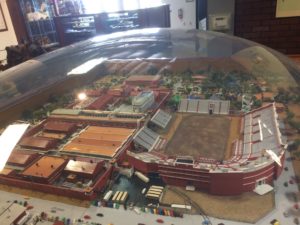
A model of the Huntsville Unit is on display at the Texas Prison Museum. The stadium where the rodeo was held is on the right (George Slaughter photo)
The Texas Department of Corrections today is known for rehabilitating prisoners and, in certain cases, performing executions. But in 1931, it became known for staging a popular rodeo that gave inmates to do something out of the ordinary while entertaining the general public.
Marshall Lee Simmons initiated the rodeo. He was the general manager of the Huntsville Prison Unit (known to many as “The Walls”).
The rodeo, held in October, featured the usual events one might expect from a rodeo: bareback riding, bronco riding, bull riding, calf roping, and wild calf milking. Simmons arranged for inmates from other area prisons to be brought to Huntsville to participate. He also made arrangements for the livestock.
The rodeo became very popular and a grandstand was built within two years of the rodeo’s opening. In 1950, a permanent stadium was built. It stood on the east side of the Huntsville Unit.
The rodeo proved popular not just with those who attended, but with local townspeople, who opened their restaurants and stores to accommodate the tourists coming to visit Huntsville.
Women also participated in the rodeo for a time before they were transferred in 1981 to the Christina Melton Crain Unit in Gatesville, 168 miles away from Huntsville. The cowgirls participated in activities such as barrel racing, calf roping, and greased pig sacking.
Eventually, big-name entertainers such as Loretta Lynn, Tom Mix, and Willie Nelson performed at the rodeo. But over a period of time, a number of factors, including bad weather, a poor economy, and a lack of advertising caused drops in attendance. The final rodeo was held in 1986.
The arena itself was declared unsafe, and was demolished. An empty lot now stands there, along 14th and G streets. Later efforts to revive the rodeo failed.
The rodeo lives on in the memories of those who participated in it or watched it. In 2016, Mitchel P. Roth, a Sam Houston State University criminal justice and criminology professor, wrote Convict Cowboys: The Untold History of the Texas Prison Rodeo (University of North Texas Press).
